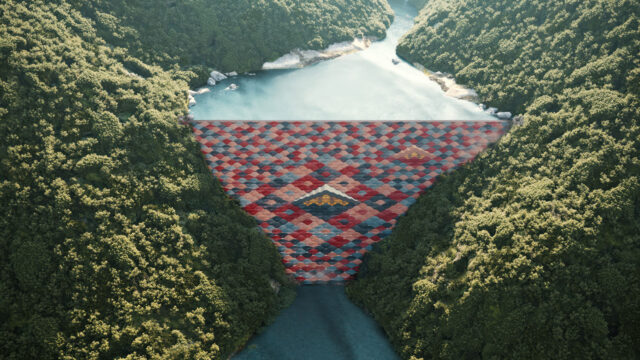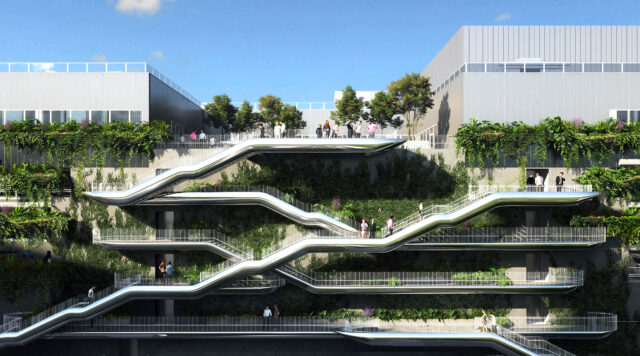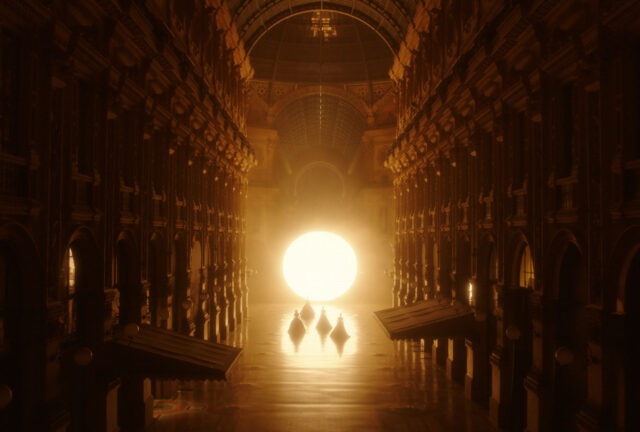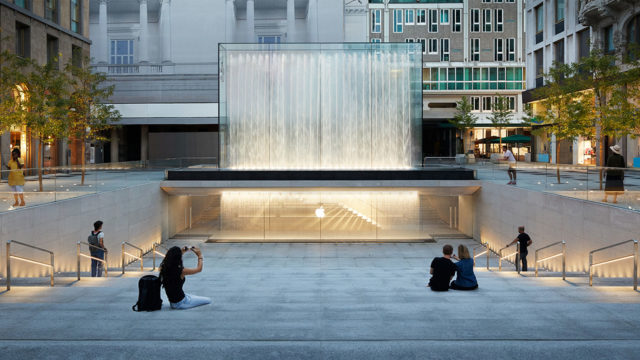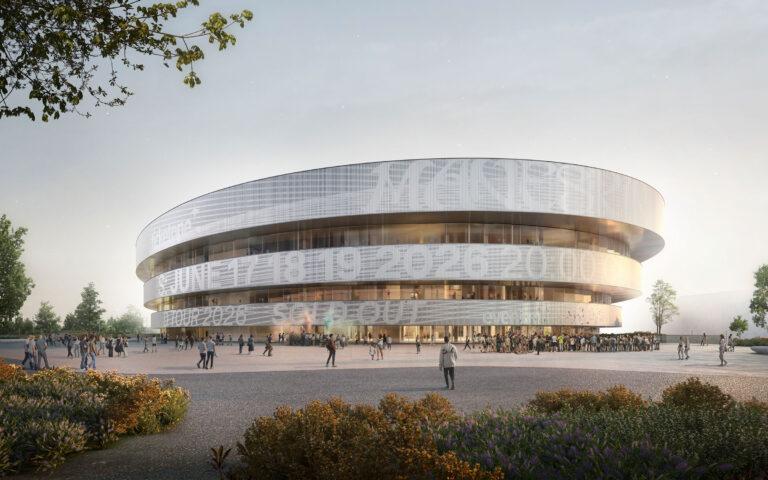
SHARE アラップとチッパーフィールド事務所による、イタリア・ミラノのアリーナ「Arena in Santa Giulia」。スポーツやイベントに対応する施設で、基壇上に3つのリングが浮かぶ意匠を特徴とし昼はアルミ素材が煌めき夜はLEDの帯により発光、2025年に完成し冬季オリンピック会場としても使用



アラップとデイビッド・チッパーフィールド・アーキテクツ・ベルリンが設計した、イタリア・ミラノの、アリーナ「Arena in Santa Giulia」です。スポーツやイベントに対応する施設で、基壇上に3つのリングが浮かぶ意匠を特徴とし昼はアルミ素材が煌めき夜はLEDの帯により発光、2025年に完成し2026年の冬季オリンピック会場としても使用されます。
こちらは建築家によるテキストの翻訳です
ミラノ・サンタジュリアは、ミラノ市の南東部に位置し、市街地からわずか数キロメートル、高速鉄道網と高速道路に接続する新都市地区として再開発が進められています。フォスター+パートナーズのマスタープランに基づき、住宅、教育、商業、レジャー、そして広大な公園からなる新市街地が開発されました。その中心となるのが 新しいアリーナは、最大1万6,000人の観客が訪れるスポーツや文化イベントに対応します。2026年初頭に開催される冬季オリンピックの会場となり、その後も大規模なコンサートやスポーツイベント、フェスティバルに利用される予定です。また、イベント開催時以外でも、広い屋外スペースは、近隣の人々だけでなく、都市全体の人々の新たな交流の場となることでしょう。
アラップとデイビッド・チッパーフィールド・アーキテクツ・ベルリンのコラボレーションによって開発されたアリーナは、長方形の敷地の最南端に配置されています。このアリーナの戦略的配置により、敷地の北側には1万㎡を超える広々とした広場が生まれ、屋外イベントの会場としても利用できるようになりました。建物の楕円形は、円形競技場の原型からインスピレーションを受け、現代の地形学と素材で再解釈されたものです。南北の軸線からわずかに回転したアリーナは、西側から到着するゲストを迎えます。このアリーナは、敷地のほぼ全域を占める高い基壇に支えられており、広い階段と基壇に切り込まれた路面レベルの入口によって来場者に開かれます。
この鉱物材料でできた基壇の上に、アリーナは高さの異なる3つのリングを重ね、擬似的に浮いているような形でそびえ立っています。その金属的な素材感は、日中はアルミチューブのきらめきによって、夜間は大規模なメディア統合のLEDストリップの光によって特徴づけられています。リングとリングの間は、透明なガラスのバンドと床でつながっています。広場に向かって、リングは不規則に突出し、建物にダイナミックなフォルムを与えています。また、基壇とアリーナの硬質な素材感に対して、階段下に広がる木々の有機的な緑地が、緑の丘陵地を思わせます。
アリーナ内部は、地上レベルの上に2つの層があり、さらにラウンジやスカイボックスのある層もあります。全席に広々としたロビーがあり、ケータリングやサービス施設も充実しています。駐車場は、基壇の中に必要な台数を配置し、さらに基壇から北側に展開する立体駐車場を設け、敷地を塞ぎます。資源消費とCO2排出を最小限に抑えるための施策に加え、サステナビリティ・コンセプトとして、屋上に太陽光発電システムを設置し、敷地内で発電したエネルギーでエネルギー効率の高い建物の需要をほぼまかなうことができます。
以下の写真はクリックで拡大します




以下、建築家によるテキストです。
Milano Santa Giulia, a new urban district is under redevelopment in the south-east of Milan, only a few kilometres from the city centre and connected to the high-speed train network and motorway. Evolved on the basis of a masterplan by Foster + Partners, the new city district encompasses residential buildings, buildings for education, commerce and leisure as well as an extensive park. The centrepiece of the area is a new arena, catering for sports and cultural events with up to 16,000 visitors. It will serve as a venue for the Winter Olympic Games in early 2026 and will subsequently be used for large concerts, sports events and festivals. Outside of event hours, the wide outdoor areas will also provide a new opportunity for social interactions for people from the neighbourhood as well as from the whole city.
The arena, which is being developed in a collaboration between Arup and David Chipperfield Architects Berlin, is placed in the extreme south of the rectangular site. The strategic position of the arena creates a spacious piazza of over 10,000 square metres in the northern section of the site, which can also be used as a venue for outdoor events. The elliptical form of the building is inspired by the archetype of the amphitheatre, being reinterpreted with modern tectonics and materials. Slightly rotated from the north-south axis, the arena welcomes arriving guests from the west. It is supported by a raised podium that occupies almost the entire site and opens up to visitors via a wide flight of steps as well as an entrance cut into the podium at street level.
On top of this podium made of mineral materials, the arena rises up in the form of three rings of differing heights, quasi floating on top of each other. Their metallic materiality is characterised by the shimmering aluminium tubes during the day and the LED strips of the large-scale media integration that light up at night. The rings are connected by light, transparent glass bands in the spaces in between as well as with the floor. Towards the piazza, the rings project irregularly, giving the building its dynamic form. The hard materiality of the podium and the arena is counterbalanced by organically designed green spaces with trees that extend down the staircase, reminiscent of a green hilly landscape.
Inside the arena, there are two tiers above the parterre level as well as a level with lounges and sky boxes. All seats are accessible via spacious lobbies at all levels, as are catering and service facilities. The necessary car parking spaces are located within the podium as well as in a multi-storey car park that evolves from the podium, closing off the site to the north. In addition to measures to minimise the consumption of resources and CO² emissions, the sustainability concept includes photovoltaic systems on the roof, whose energy generated on site largely covers the needs of the energy efficient building.
■建築概要
Concept study: 2021
Project start: 2021
Construction start: 2022
Completion due: 2025
Capacity: 16,000 (12,000 seats, 4,000 standing)
Client: CTS Eventim Group
Architect: Arup with David Chipperfield Architects Berlin
Partners: David Chipperfield Architects Berlin David Chipperfield, Harald Müller, Alexander Schwarz
Project architects: Guido Porta (Concept study), Leander Bulst (Preparation and brief to Developed design, Design intent details)
Project team: Guido Porta, Luigi Serra, Michael Ahlers, Moritz Grabmayr, Theresa Rauch
Concept study team: Annette Flohrschuetz, Julijana Steimle, Lucas Fricke;
Visualisation: Dalia Liksaite
───
In collaboration with
Quantity surveyor: Global Assistance Development S.r.l., Milano
BIM consultant, Structural and geotechnical engineer, Mechanical, electrical and Public health services engineer, ICT and audio-video consultant, Security consultant, Sustainability consultant: Arup
Acoustic consultant: Arup; Studio MRG, Torino
Fire consultant: Arup; Studio Mistretta & Co., Milano
Façade engineer: and access
and maintenance consultant, Lighting consultant, Traffic consultant: Arup
Civil Works consultant: Studio AGN, Locate di Triulzi
Landscape agronomist: Studio Laura Gatti, Milano


